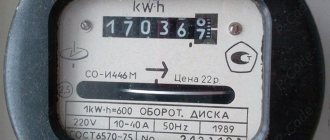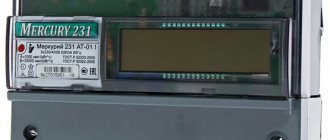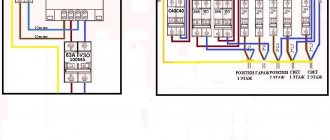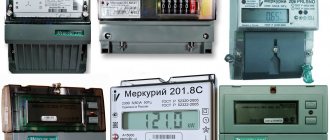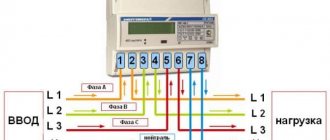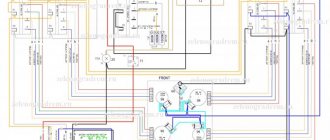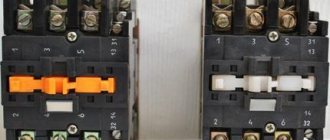The Mercury 201 meter is a single-phase, single-tariff device for determining consumption indicators for active electrical energy and power parameters of variable two-wire networks. The product is suitable for use by individuals or companies for the purpose of individual commercial or organizational metering of consumed electricity, provided that it is installed in a protected area.
Meter type – Mercury 201
Design and principle of operation
The body of the electric meter, consisting of a base, main and terminal covers, contains the following components:
- terminal strip with shunt;
- an electronic unit, including a power circuit, a removable battery, built-in memory, a pulse output, a control element;
- built-in modem for remote data transfer (for versions with LCD);
- liquid crystal display or mechanical calculating device (depending on modification).
The design of the meter is Mercury 201, in order to finally disassemble the meter you need to unscrew the screw shown by the arrow
The electrical energy passing through the device circuit is recorded by an electronic board, which, after processing the signal, displays data on the screen or reads it on a mechanical display. At the same time, the information is recorded by the telemetry system and transmitted to a modem connected to a remote monitoring device.
Connecting the meter
Before connecting the device, the power supply is turned off. The product is mounted on a DIN rail, the terminal box cover is removed, and the wires are connected according to the diagram presented in the passport documentation. Additionally, the circuit is made on the terminal cover.
For models with LCD and modem, additional configuration of the product software will be required.
An electrician with an electrical safety group of third and higher is allowed to perform work.
After connection, a corresponding entry is made in the passport column about putting the electric meter into operation.
Specifications
| Characteristics | Magnitude |
| Rated voltage (Unom), V | 230 |
| Set operating voltage range in relation to Unom | 0,9 — 1,1 |
| Extended operating range in relation to Unom | 0,8 — 1,15 |
| Limit operating range in relation to Unom | 0 — 1,15 |
| Basic current value (Ib), A | 5 or 10 |
| Maximum current value (Imax), A | 60 or 80 |
| Accuracy class | 1 or 2 (indicated on the scale) |
| Rated frequency value, Hz | 50 |
| Starting current (sensitivity), A, no more: | |
| for a meter with Ib=5 A for a meter with Ib=10 A | 20 or 10 40 or 20 |
| Constant (gear ratio) of meters, imp/kWh | 6400 or 5000 or 3200 |
| Liquid crystal indicator: | |
| number of displayed digits unit price of the least significant digit when displaying energy, kWh | 8 0,01 |
| Reading device: | |
| number of displayed digits unit price of the least significant digit when displaying energy, kWh | 6 0,01 |
| Number of tariffs | 1 |
| Total power consumed by the current circuit, V*A, no more | 0,1 |
| Active power consumed by the voltage circuit, W, no more than: | |
| for meters for meters with PLC modem | 2 3,5 |
| Total power consumed by the voltage circuit, V*A, no more than: | |
| for meters for meters with PLC modem | 10 25 |
| Overall dimensions of the meter, mm, no more: | |
| height width length | 105 or 91 105 or 77 64 or 66 |
| Meter weight, kg, no more | 0,34 |
| Established operating temperature range, °C * for versions 201.7, 201.8 | -40… +55 *-45… +75 |
| Average time to failure, hours. | 220000 |
| Standard service life, years | 30 |
| Calibration interval, years | 16 |
| Price, increased rub. | from 660 |
Overall dimensions of the meter - Mercury 201
Description of the Mercury 201 counter
AC active energy watt-hour meters electronic Mercury 201, direct switching, single-phase, single-tariff, with pulse output, designed for measuring and accounting for electrical active energy in two-wire AC networks with a voltage of 230 V, frequency (50±1) Hz.
The principle of operation of electronic AC active energy watt-hour meters "Mercury 201" is based on taking into account information received from the pulse output of the measuring microcircuit. The meters use a shunt connected in series with the current circuit as current sensors. Resistive dividers connected to a parallel voltage circuit are used as voltage sensors.
As a counting mechanism, the meters have electromechanical readout devices (CD) or liquid crystal indicators (LCD) according to Table 1.
Meters with UO provide information display in the form of six-digit numbers, the five highest digits give readings in kWh, the sixth digit, separated by a comma, indicates the value of electricity in tenths and hundredths of kWh.
Meters with LCD provide a cumulative display of energy consumption in the form of eight-digit numbers, the six highest digits give readings in kWh, the two lowest ones indicate tenths and hundredths of kWh. They have a light indication of power consumption. The flickering period of the indicator light is proportional to the level of energy consumption. The meters have an electrical and/or optical pulse output as a test output device. They can be used autonomously or in automated systems for collecting and recording information about consumed electricity.
Mercury 201 electricity meters consist of the following components:
- housing (case base, housing cover, terminal cover);
- terminal block;
- printed circuit assembly.
The printed circuit assembly is a board with electronic components that is installed at the base of the housing. The printed circuit board is connected to the terminal block using wires. The housing cover is attached to the base with latches and one or two screws (depending on the modification) and has a window for reading readings from the LCD (LC) and for observing the LED operation indicator. The terminal block consists of four terminals for connecting the mains and load.
On the printed circuit there are:
- power unit;
- pulse output optocoupler;
- microcontroller (MK);
- non-volatile storage device;
- LCD (UO).
Mercury 201 electricity meters are intended for use indoors. The degree of protection of meters against penetration of dust and water is IP51.
Mercury 201 has several versions, differing:
- base and maximum current;
- accuracy class;
- counter constant;
- a device for displaying metered electricity;
- the presence of an electrical and (or) optical test output;
- functionality;
- climatic design;
- type of housing.
Options for the Mercury 201 electricity meters are shown in Table 1.
Options for Mercury meters series 201
| Counter modifications | Meter constant, imp./(kWh) | Base (maximum) current, A | Indicator type | Additional functions |
| Mercury 201.1 | 6400 | 5(60) | UO | — |
| Mercury 201.2 | 6400 | 5(60) | LCD | — |
| Mercury 201.22 | 6400 | 5(60) | LCD | PLC |
| Mercury 201.3 | 6400 | 10(80) | UO | — |
| Mercury 201.4 | 6400 | 10(80) | LCD | — |
| Mercury 201.42 | 6400 | 10(80) | LCD | PLC |
| Mercury 201.5 | 3200 | 5(60) | UO | — |
| Mercury 201.6 | 3200 | 10(80) | UO | — |
| Mercury 201.7 | 3200 | 5(60) | UO | — |
| Mercury 201.8 | 5000 | 5(80) | LCD | — |
| Mercury 201.82 | 5000 | 5(80) | LCD | PLC |
| Mercury 201.9 | 3200 | 10(80) | UO | — |
- U O - electromechanical reading device
- LCD - liquid crystal indicator
- PLC is a modem module for transmitting information over a power network.
A general view of electronic AC active energy watt-hour meters "Mercury 201", manufactured in different housings, is presented in Figures 1 - 4.
The sealing diagram against unauthorized access and the designation of the place where the verification mark is applied are presented in Figures 5, 6.
The verification mark is applied by pressure to a hinged seal or special mastic.
Figure 5 - Scheme of sealing against unauthorized access, designation of the location of the meter verification mark “Mercury 201.7”, “Mercury 201.8”, “Mercury 201.82”, “Mercury 201.9”
Figure 6 - Scheme of sealing against unauthorized access, designation of the location of the meter verification mark “Mercury 201.1”, “Mercury 201.2”, “Mercury 201.22”, “Mercury 201.3”, “Mercury 201.4”, “Mercury 201.42”, “Mercury 201.5”, "Mercury 201.6"
Device warranty
The manufacturer accepts the product for warranty repair if, within 3 years from the date of installation or after 42 months from the date of production, a failure occurs due to a manufacturing defect.
The consumer or trade organization providing the product for warranty service must attach the device passport. If traces of mechanical damage or the results of improper connection and operation of the device are detected, the manufacturer withdraws its warranty obligations.
Connecting Mercury 230 via current transformers
The electric meter is connected via current transformers using a ten-wire cable. This helps to replace and check the connection circuit of the device, allows you to determine the error in measurements directly at the installation site of the electric meter in the presence of load current without disconnecting consumers.
Next, the old meter is dismantled.
The two remaining contacts are attached in the same way.
Data from the transformer terminals is sent to a metering device that records the amount of generated electrical energy. One of them is connection through ten separate conductive wires. As a rule, voltage circuits are made with the same cross-section as current circuits. As was written above, metering circuits must be connected to clamp assemblies or test blocks, so what is a test block?
Advantages of the device
The manufacturer offers products with the following advantages:
- protection from outside influences;
- attractive design of the case and screen;
- compact dimensions;
- convenient installation - the kit additionally includes an adapter bracket for easy installation of the product on mounting bolts from meters of obsolete brands;
- the ability to remotely transfer information and connect to third-party devices (for certain versions);
- the presence of an alarm system notifying about the intensity of electricity consumption;
- affordable price;
- compliance with established state standards for measurement accuracy;
- function of recording basic characteristics in the built-in memory;
- energy independence due to the presence of autonomous power supply;
- durability and long intervals between verifications.
Types of counter
The manufacturer produces this model in six versions:
- 201.2 – modification with a liquid crystal display, constant value – 6400 pulses. per kW*h and the value of the operating (limit) electric current, respectively, 5 (60) A;
- 201.4 - current parameters differ from the previous version, amounting to 10 (80) A;
- 201.5 - current characteristics are similar to version 201.2, but instead of an LCD, a roller mechanical display is installed, and the constant is half as much;
- 201.6 – a complete analogue of the previous version, with current parameters identical to model 201.4;
- 201.7 – similar to model 201.5, differs in the design of the housing;
- 201.8 – version with a current value of 5 (80) A, constant – 5000 pulses. for kWh and LCD.
Characteristics of varieties of Mercury 201
In addition to the specified features, all versions are manufactured with accuracy classes 1 and 2 and are assembled in 4 housing options.
Requirements for the meter
Before purchasing an electric meter, you need to check whether it meets all the necessary requirements. This includes the presence of an accuracy class, usually for electricity metering devices this is the first or second class, which allows a measurement error of 1-2%.
It is also worth checking in advance whether the date of production and verification of the meter is indicated. It is imperative to check the number for availability in the State Register database of measuring instruments and the warranty seal on the device itself. And it’s worth making sure that you have the verifier’s mark and a protective hologram.
Replacing the battery
The device's autonomous power supply is installed inside, under the main housing cover. Depending on the design of this structural part, it is removed after unscrewing two screws or releasing the latches.
The battery is designed to last at least the duration of the verification interval, so it must be changed during the verification process. The case cover is sealed, so the user will not be able to get to the battery on his own.
After removing the cover, the old battery is removed and a new one is inserted in its place, with a similar arrangement of positive and negative poles.
Taking readings
To take readings, the consumer must:
Taking readings from the meter - Mercury 201
- Write down the number (circled in blue in the photo) indicating the integer value of kilowatt-hours from the liquid crystal display or roller display (depending on the modification). Fractional shares that are not subject to accounting are displayed to the right of the decimal point. For versions with LCD there will be two of them, for a mechanical scoreboard there will be one, made in red.
- Previous readings are subtracted.
- The result is multiplied by the cost of one kilowatt-hour.
Design features and connection diagram
The device consists of a plastic case, a cover, a terminal block, an optocoupler, a volatile memory device, an optoport, a microprocessor and a liquid crystal monitor. There are two connection options. Can be connected directly or semi-indirectly using current three-phase transformer installations. As for direct connection, the device is connected directly to the power line according to the instructions using input machines.
You might be interested in Electric meter Co i446
Note! As for semi-indirect connection and installation, this circuit uses a phase network conductor. It is worth pointing out that there is also an autotransformer, indicated in the diagram
Mercury connection 201
